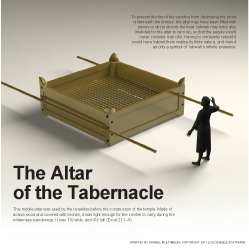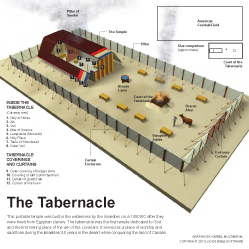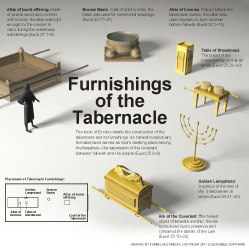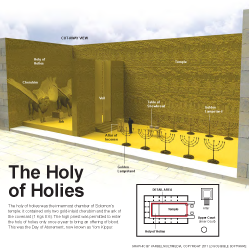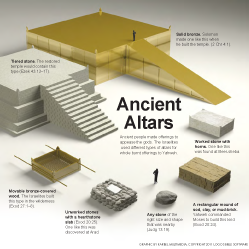4:1–5:13 This passage provides a detailed treatment of the chatta'th, a Hebrew word commonly translated as “sin offering” because the Hebrew verb chata means “sin” or “miss the mark.” However, the chatta'th is prescribed for situations that do not result from sin, such as the purification needed following childbirth (see Lev 12). Since the verb chata can also be used for purification, describing actions that counter the effects of sin, chatta'th may be more broadly translated as “purification offering.” Its purpose was restoring ritual purity to a person (and the sanctuary), as opposed to atoning for a moral offense. For example, in 8:14–15, the blood from a chatta'th sacrifice is used to purify (yechatte) the altar. This sacrifice did not atone—and thus absolve the guilty—for every kind of sin. Deliberate sins against God (those committed with presumption) could not be atoned for by this or any sacrifice (see Num 15:30–31). Unlike the discussions of the burnt offerings, grain offerings, and peace (fellowship) offerings, which focused on the sacrifice rather than the one bringing the sacrifice, the regulations for purification (or sin) offerings in this section are categorized according to the nature of the offense and the offender. The required animal for the sacrifice is different depending on who sinned—the high priest, the whole community, a leader, or an average person. The purification offerings fall into two main categories—ones that purify the sanctuary and the altar and ones that only cleanse the altar. The first type could not be eaten at all (Lev 6:30). The second type could be eaten by the priests (see 6:25–29). |
4:1 Yahweh spoke to Moses This is the first heading since 1:1, and it marks the beginning of a distinct section. The offerings described in chs. 1–3 were motivated by the willing obedience of the worshiper. The offerings outlined in 4:1–6:8 were required for the atonement of sin.
4:2 If a person sins by an unintentional wrong To sin without intent or inadvertently means the wrong was due to ignorance of the law or negligence that brought about an unintended result, such as accidentally killing someone (Num 35:11). The assumption is that obedience, not defiance, is the default response and that one who knew and understood the law would seek to obey it.
 Types of Offerings in the Old Testament Table
Types of Offerings in the Old Testament Table
4:3 anointed priest Referring to the high priest, the main one who is anointed with oil (see Lev 21:10 and note). This regulation likely addresses violations committed in an official capacity, not the priest’s personal sins, since the cure involved cleansing the sacred space of the tabernacle.
bringing guilt on the people The sins of the high priest affect the entire congregation because he represents the people before God. In the other cases, the guilt is associated with the one who sinned, not the people in general. The high priest’s sin brought guilt on the people just as when the whole congregation sinned (v. 13).
 Functions of Priests Table
Functions of Priests Table
a sin offering When a person unknowingly sinned, the offense affected the sanctity of the sanctuary. The Hebrew word used here, chatta'th, refers to an offering that cleansed the contamination—in this regard it may be described as a purification (sin) offering (see note on 4:1–5:13). When both the purification offering and the burnt offering were offered, the former was always performed first to cleanse the altar before the latter (see 9:7–21; 14:19).
4:4 slaughter the bull before Yahweh The bull is killed in the courtyard of the tabernacle, north of the bronze altar (see note on 1:5).
(see note on 1:5).
4:5 some of the bull’s blood Violations by the high priest (as representative for the community) or by the community itself had a collective effect of bringing greater impurity. Blood had to be taken inside the tent shrine to purge the impurity.
4:6 shall spatter some of the blood The blood is the ritual cleanser that purges the impurity. The blood is handled differently in this sacrifice than the burnt offering (1:4–5) or peace (fellowship) offering (3:2). Here it is sprinkled (nazah in Hebrew) in front of the tent shrine, not dashed (zaraq in Hebrew) against the altar.
is the ritual cleanser that purges the impurity. The blood is handled differently in this sacrifice than the burnt offering (1:4–5) or peace (fellowship) offering (3:2). Here it is sprinkled (nazah in Hebrew) in front of the tent shrine, not dashed (zaraq in Hebrew) against the altar.
seven times Similar purification rituals also call for sevenfold sprinkling of water, oil, or blood. For example, someone being purified from a skin disease was spattered with blood seven times (14:7). Moses consecrated the altar by spattering it with oil seven times (8:11). The cleansing rituals for the Day of Atonement also required sprinkling blood on or around the ark of the covenant seven times (16:14).
the sanctuary’s curtain Refers to the thick curtain separating the two parts of the tent shrine (see note on Exod 26:31–36)—the holy place and the most holy place (holy of holies). The altar of incense
The altar of incense was in front of this veil, and the ark of the covenant
was in front of this veil, and the ark of the covenant was behind the veil.
was behind the veil.
4:7 the horns of Ancient Near Eastern altars were often constructed with horns at the corners. The horn was a symbol of power (Jer 48:25; Zech 2:4). Removing the horns from an altar rendered it unusable and defiled (Amos 3:14). Placing the blood on the horns served to cleanse the whole altar. See note on Exod 27:2.
the altar of fragrant incense The altar inside the tent, directly in front of the veil that separated the holy place from the most holy place. For more on the altar of incense, see note on Exod 30:1.
see note on Exod 30:1.
the base of the altar of the burnt offering The blood for the purification (sin) offering is used to purify the small incense altar inside the tent shrine and the large sacrificial altar in the courtyard. The text carefully distinguishes the two altars by name and location. The altar of incense is in the tent and the altar of burnt offering is at the “entrance of the tent of meeting,” another name for the courtyard outside the tent shrine (see note on Lev 1:3).
4:8 the fat from the bull of the sin offering The fat and the blood were the two substances from a sacrificial animal that belonged to Yahweh exclusively. Essentially the same list of fatty portions that should be offered on the altar appears three times in ch. 3 (see 3:3 and note).
4:10 just as it is removed The text acknowledges the overlap in procedure with the zevach shelamim (3:3–5), but only after repeating the details explicitly. However, future descriptions for other offerings of this type are abbreviated by simply noting the procedure is the same as for the first chatta'th (e.g., v. 20).
4:12 all of While the fatty portions are all burned on the altar of burnt offering, the remainder of the bull’s carcass—its skin, flesh, and other entrails—was taken outside the camp and burned. The animal was not burned on the altar, only the fat. The rest of the animal could not be eaten because some of the blood had been taken inside the tent of meeting (6:30).
a ceremonially clean place The Hebrew term used here, maqom tahor, indicates a ritually pure site. The contrast is between ritually pure and impure and is not about physical cleanliness.
4:13–21 This passage addresses unintentional sin for which the entire congregation of Israel is responsible. The ritual procedures for the purification offering for the community’s sin are essentially the same as for the unintentional sin of the high priest. Many of the details are repeated explicitly, but some descriptions are abbreviated with reference to the previous procedure (see vv. 20–21). In both of these cases, the purification offering cleanses guilt that has ramifications for the whole community (compare vv. 3, 13). Since some of the bull’s blood is sprinkled inside the tent of meeting for this offering as well, it could not be eaten either (see 6:30). |
4:13 Israel’s whole assembly Probably refers to the entire nation of Israel—every man, woman, and child. This Hebrew phrase is used throughout the Pentateuch (e.g., Exod 17:1; Num 1:53; 20:1).
did wrong unintentionally The error must result from ignorance or negligence (see note on Lev 4:2). Possibly, the entire congregation sinned as a result of the high priest making an error. Verses 1–21 could be addressing a single case where the priest’s mistake led to the people inadvertently violating God’s commandments.
assembly’s This passage uses two different Hebrew terms for the community of Israel as a group: edah (“congregation”) and qahal (“assembly”). Both labels most likely designate the entire people of Israel since they appear to be used interchangeably in these verses (vv. 13–15).
4:14 a young bull The purification (sin) offering for cleansing the greater impurity caused by a sin of the congregation or the high priest had to be a bull—the most costly sacrificial animal.
4:15 the elders of the community The leaders of the community (see Exod 3:16 and note). The total number of elders at any given time is unknown, but the elders of the entire nation would have been a very large group. In Exod 24:1, a group of seventy elders is selected to represent the people. Here it is likely a small representative group of elders participating in the ritual on behalf of the entire congregation.
4:16–18 The blood ritual described here is identical to that outlined in Lev 4:5–7. The account here was abbreviated slightly as a result. For example, the text refers to the “veil” whereas before it specified “veil of the sanctuary” (v. 6). The priest sprinkles the blood inside the tent shrine seven times, places some blood on the horns of the incense altar in the holy place, and then pours out the rest at the base of the sacrificial altar in the tabernacle courtyard. |
4:17 in front of the curtain The Hebrew phrasing used here (and in v. 6) could mean either that the blood was sprinkled before the veil (curtain) or directly on the veil (curtain).
4:19 all its fat The detailed list of what is meant here can be found in Lev 4:8–9. Rather than repeat these details for the other purification (sin) offerings, the text simply uses this phrase for the four types discussed in 4:22–5:10.
4:20 shall make atonement A central purpose of the purification (sin) offering is making atonement or purging uncleanness, which is the focus of the ot sacrificial system. The result of atonement is forgiveness.
will be forgiven The Hebrew term used here is salach. Based on ancient Near Eastern parallel terms, the basic meaning is “to cleanse.” Once God accepts the purging of the atonement, there is cleansing. Salach is used in contexts of pardoning guilt (Exod 34:9; Num 14:19–20).
4:21 first bull Rather than repeat the instructions in detail, here the writer simply refers back to the procedures enumerated in Lev 4:11–12 (see note on v. 12).
the sin offering for the assembly This offering served to purify or remove guilt from the entire community. Since some of the blood was sprinkled inside the tent shrine, just as with the purification offering for the high priest, this offering could not be eaten according to 6:30. See note on v. 13.
4:22–35 From here through the end of the chapter, the regulations address purification (sin) offerings relevant to sins that do not have the same level of impact on the entire community. The sin of a high priest brought guilt on all the people (v. 3), and the sin of the congregation also affected the group collectively (v. 13). The sins of other individuals, even leaders (vv. 22–26), only impacted themselves, so their offerings atoned for their own sins (vv. 26, 31). The blood ritual described for these offerings differs slightly from the earlier ones (compare vv. 7, 18). Only the main altar in the courtyard is involved with blood daubed on the horns and the rest poured out at the base (vv. 25, 30, 34). Also the priest was permitted to eat the meat of these sin (purification) offerings (6:24–29). |
4:22 a leader sins The Hebrew term nasi (“leader”) has a broad range of usages, but generally designates a civil or secular leader such as the head of a tribe or clan.
4:23 a male goat without defect as his The goat was a more common and less costly sacrifice for a sin (purification) offering (chatta'th in Hebrew) than the bull. The chatta'th offering for people on the Day of Atonement and on the Feast of Weeks is also a male goat (see 16:5, 9, 15; 23:19).
is also a male goat (see 16:5, 9, 15; 23:19).
4:24 in the place where The animal is slaughtered in the same location as the burnt offering, in the courtyard on the north side of the altar. See note on 1:5.
4:25 the horns of the altar of the burnt offering The procedure for this sin (purification) offering is comparable to the other offerings. Some blood is put on the horns of the altar while the rest of the blood is poured out similar to other sin offerings (vv. 3–12, 13–21). However, this is a different altar—the previous two sin offerings had the blood placed on the altar of fragrant incense in front of the veil (curtain), inside the tent of meeting (vv. 7, 18). Those two offerings, covering an unwitting sin of the high priest and the entire congregation, required greater sanctity than the same offense by one of the leaders of the camp who was not a priest.
4:26 the fat of the fellowship offerings’ sacrifice The parts of the animal offered on the altar are explicitly identified as the same as those offered for the peace (fellowship) offerings (see note on 3:3).
4:27–35 The procedure for the final two sin or purification (chatta'th in Hebrew) offerings is essentially the same as that for the leader. The primary difference is that a common person can bring a female goat (vv. 27–31) or sheep (vv. 32–35) instead of a male goat. |
4:27 people of the land Chapter 4 has moved in degrees of sanctity—from the high priest, to the Israelite people as a whole, to leaders who were not priests, to other common people (likely non-Israelites)—addressed here.
4:32 a lamb The Hebrew term keves is often translated “lamb” but likely refers generally to sheep since texts that use the word often explicitly indicate the age of the sheep (compare Exod 12:5; Lev 9:3; 14:10; Num 6:14).
4:35 upon The fat is most likely burned on the altar beside the other offerings. The preposition used here (al) can also mean “with” and “beside” as well as “upon.” See note on 3:5.

|
About Faithlife Study BibleFaithlife Study Bible (FSB) is your guide to the ancient world of the Old and New Testaments, with study notes and articles that draw from a wide range of academic research. FSB helps you learn how to think about interpretation methods and issues so that you can gain a deeper understanding of the text. |
| Copyright |
Copyright 2012 Logos Bible Software. |
| Support Info | fsb |
 Loading…
Loading…

